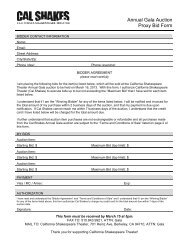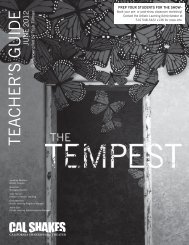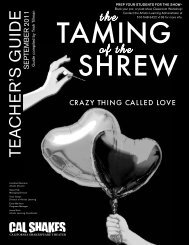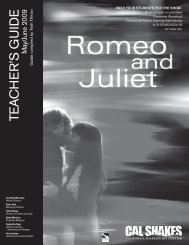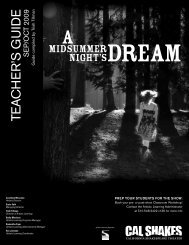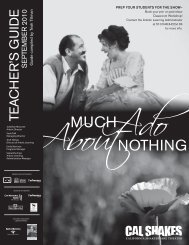Twelfth Night teacher's guide - California Shakespeare Theater
Twelfth Night teacher's guide - California Shakespeare Theater
Twelfth Night teacher's guide - California Shakespeare Theater
You also want an ePaper? Increase the reach of your titles
YUMPU automatically turns print PDFs into web optimized ePapers that Google loves.
GETTING DRESSED FOR THE PARTY:<br />
Identity and Disguise<br />
Viola disguises herself as a man. Malvolio dreams of a “branched velvet gown.”<br />
Feste shows up at the party wearing a skirt. These are just three characters using—or<br />
wanting to use—clothes to identify themselves in a certain way.<br />
Think about what “identity” meant in <strong>Shakespeare</strong>’s time. Clothes were considered<br />
to be the definition of the person and the person was defined by social status.<br />
Your social standing was your identity. To change one’s clothes was to clearly and<br />
definitively change one’s self. Therefore Malvolio’s humiliation in his yellow stockings<br />
cuts even more deeply that we might imagine.<br />
The statutes of the time prohibited the wearing of certain types of materials and<br />
colors according to what class you were. Violating the sumptuary laws could result<br />
in fines, punishment and, in medieval times, even death! Read all about Elizabethan Sumptuary Laws and why<br />
Queen Elizabeth was forced to issue new proclamations about clothing at http://www.elizabethan-era.org.uk/<br />
elizabethan-sumptuary-laws.htm.<br />
Of course there is always the internal or emotional idea of what one’s own identity is, and Viola knows who she is<br />
at all times, even in the midst of the confusions between herself as Cesario and Sebastian. She knows she is a<br />
woman, she knows who she loves, and she knows how to survive even in disguise.<br />
These are a few examples of how people use disguise and change of identity in <strong>Twelfth</strong> <strong>Night</strong>:<br />
• Orsino sends Cesario to woo Olivia rather than going in person.<br />
• Viola dresses as a man to in order to get a job and survive in a new city.<br />
• Olivia dresses in mourning to express her sadness at the deaths of her brother and father.<br />
• Olivia puts a veil over her face when Viola/Cesario arrives for the first time in order to confuse the<br />
messenger.<br />
• Maria pretends to be Olivia, imitating Olivia’s handwriting in the letter to Malvolio, which convinces<br />
him that Olivia secretly loves him.<br />
• Malvolio puts on extravagant yellow, cross-gartered stockings and a big smile to show Olivia he is<br />
worthy of her love.<br />
• Feste dresses and talks as a priest when he talks to Malvolio in his “prison.”<br />
Try This:<br />
IDENTITY:<br />
Think about what clothes mean today.<br />
Is what people wear important?<br />
Do your clothes say something about who you are?<br />
Do you think clothes should affect how others think of<br />
you or not?<br />
Have you ever had the feeling of being out of place<br />
because of the way you were dressed?<br />
Can you think of a time that you judged someone<br />
because of the way they dressed?<br />
DISGUISE:<br />
How do people use disguise today?<br />
Think about your profile on MySpace<br />
or Facebook, even what ringtone you<br />
might choose on a cell phone. What do<br />
you want to show to others? What do<br />
you want to hide? What do you want<br />
people to think of you?<br />
Can people use just words (in texting,<br />
or talking, or emailing) to disguise<br />
themselves? How?<br />
PAGE 20




